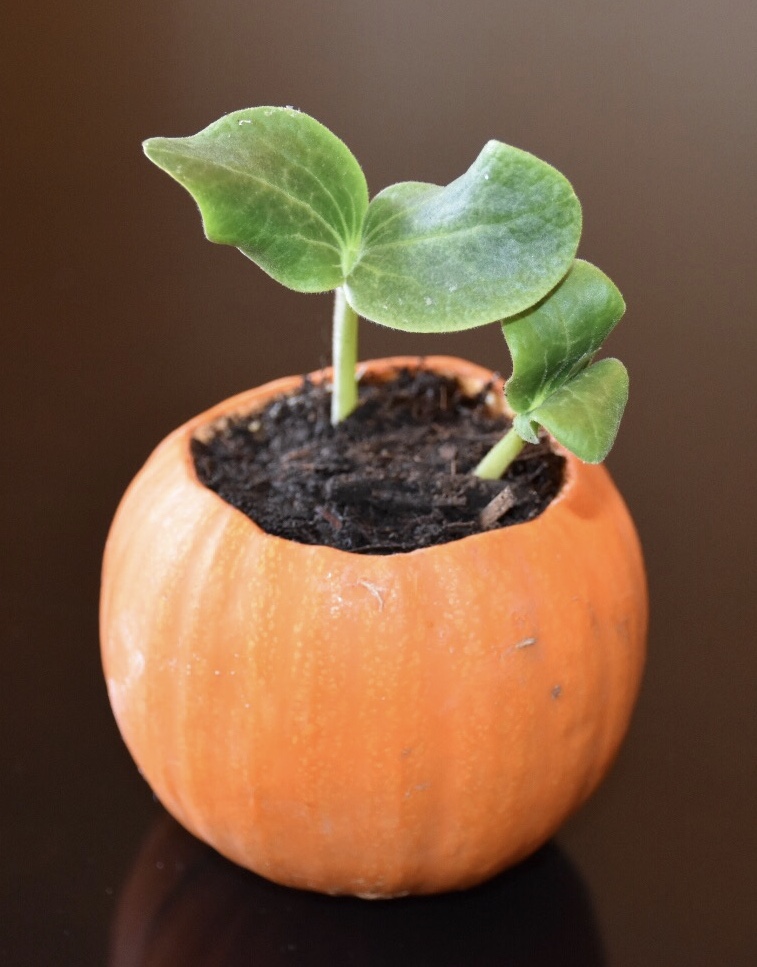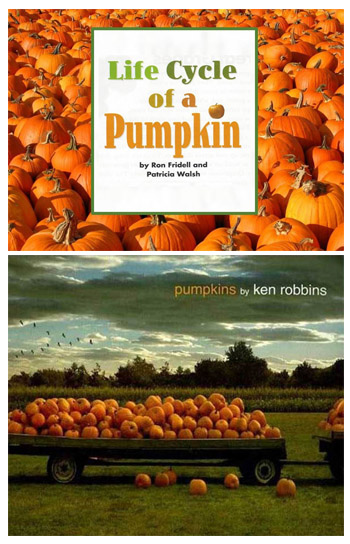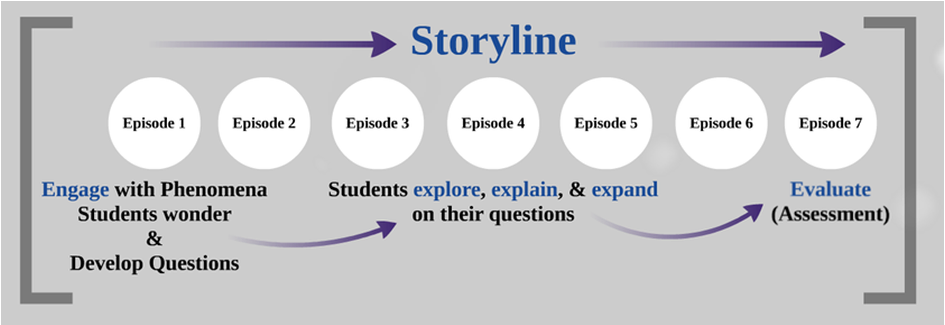 Relevancy and Engagement
agclassroom.org/
Relevancy and Engagement
agclassroom.org/
The Case of the Missing Pumpkin
Grade Level
K - 2
Purpose
Students investigate the phenomenon of decomposing pumpkins as a part of the plant's life cycle. Grades K-2
Estimated Time
2 hours instruction time plus 1-2 months for observation
Materials Needed
Engage:
- Sophie's Squash by Pat Zietler Miller
Activity 1: Decomposing Pumpkin
- Jack-o-lantern with seeds and fibrous strands intact
- Pumpkin Jack by Will Hubbell
- Decaying Halloween Pumpkin Time Lapse video
- Rotten Pumpkin: A Rotten Tale in 15 Voices by David M. Schwartz
- Aquarium
- Soil
- Pumpkin Science Journal
- How Does Mold Grow? video
Activity 2: Pumpkin Planters
- Mini pumpkins, 1 per student or larger pumpkins, 1 per group (with the tops of the pumpkin removed)
- Potting soil
- Garden trowels or spoons
- Pumpkin Science Journal
Activity 3: The Great Pumpkin
- Life Cycle of a Pumpkin by Ron Fridell and Patricia Walsh or Pumpkins by Ken Robbins
- White paper plates, 2 per student
- Black and orange markers or crayons
- Green yarn, 1 arm-length per student
- Brown, green, yellow, and orange construction paper
- Great Pumpkin Paper Patterns
- Hole punch
- Stapler
- Scissors
Vocabulary
bacteria: a group of single-celled living things that cannot be seen without a microscope that reproduce rapidly and sometimes cause diseases
decomposer: an organism that feeds on and breaks down dead plant or animal matter
decomposition: the process of breaking down or being broken down into simpler parts or substances especially by the action of living things (as bacteria or fungi)
fungus: any species in a large group of spore-producing organisms that may be one- or multi-celled and feed on organic matter; examples include yeast, molds, and mushrooms
humus: thoroughly decomposed organic matter
nutrient: a substance that provides nourishment essential for growth and the maintenance of life
phenomenon: an observable event which is not man-made; plural form is phenomena
pumpkin: a large, rounded fruit with a thick rind, edible flesh, and many seeds
Did You Know?
- Pumpkins are 90% water, high in fiber, and contain potassium and Vitamin A.
- Pumpkin flowers are edible.
- The town of Goffstown, New Hampshire holds an annual pumpkin regatta each October. Giant pumpkins are hollowed out to make room for a single passenger to race down the Piscataquog River.
Background Agricultural Connections
This lesson is easily nested into a storyline as an episode exploring the phenomenon of decomposition. In this episode, students investigate the question, "What happens to a pumpkin over time?" Keep in mind that phenomena-based lessons include storylines which emerge based upon student questions. Other lesson plans in the National Agricultural Literacy Curriculum Matrix may be used as episodes to investigate student questions needing science-based explanations. For more information about phenomena storylines visit nextgenstorylines.org.
The pumpkin is one of only a few foods native to North America that is still eaten today. Native Americans used pumpkins for food and medicine. Dried pumpkin shells served as bowls or containers for storing grains and seeds. Flattened strips of pumpkin were dried and made into mats.
Pumpkins were a main part of the Pilgrims' daily diet. If left uncut and stored in a cool, dry place, pumpkins can keep for several months. Colonists made pumpkin pies by slicing off pumpkin tops, removing the seeds, filling the pumpkin with milk, spices, and honey, and then baking it all in hot ashes.
Today, the majority of pumpkins grown are sold for decorating and carving. The tradition of carving pumpkins at Halloween started with the Irish. The original jack-o-lanterns were made from turnips. When the Irish immigrated to the US, they found that pumpkins were in large supply and were much easier to carve.
The pumpkin is a member of the cucurbit family which includes gourds, squash, cucumbers, and melons. Pumpkins come in a variety of shapes, sizes, and colors. Most pumpkins are orange, but they can also be yellow, red, white, gray, or pale green. Pumpkins range in size from less than a pound to over 2,000 pounds.
A pumpkin is a fruit that grows on a vine. They are typically planted in late spring or early summer for an October harvest. After a pumpkin seed sprouts, large leaves begin to grow on vines. Eventually, the vine blooms with yellow flowers. Following pollination, the female flower begins to grow a small green pumpkin that will turn orange as it continues to grow. When the vines turn brown, the pumpkins are ready to harvest.
Pumpkins left in the field will be eaten by animals or they will decompose. The phenomenon of decomposition is a natural process through which nutrients are recycled back into the soil. Insects, fungus, and bacteria are decomposers that eat the dead tissue from the pumpkin and excrete it in a form that helps live plants grow.
In nature, dead plants and animals decompose and become humus. Humus acts like a sponge to help soil hold water. It also traps air in the soil and provides nutrients. Plants need air, water, light, and nutrients to grow. When farmers plant crops in the soil, the growing crops take out nutrients. The farmers can replace those nutrients by tilling decomposing plants back into the soil. The surviving seeds left by a decomposing pumpkin have the ability to sprout and grow into a new pumpkin plant, continuing the pumpkin life cycle.
Engage
 Ask the students if they have ever carved a pumpkin into a Jack-o-lantern.
Ask the students if they have ever carved a pumpkin into a Jack-o-lantern.- Have the students predict what they think would happen to a Jack-o-lantern if they kept it until the next summer.
- Read the book Sophie's Squash by Pat Zietler Miller. Discuss with the students what happened to Sophie's squash. Could that happen to a pumpkin?
Explore and Explain
|
This lesson investigates the phenomenon of decomposition. Natural phenomena are observable events that occur in the universe that we can use our science knowledge to explain or predict. Phenomenon-Based Episode: What happens to a pumpkin over time? |
Activity 1: Decomposing Pumpkin
- Ask the students, "What happens to a pumpkin over
 time?"
time?" - Read the book Pumpkin Jack by Will Hubbell. Use information from the book and the Background Agricultural Connections section of this lesson to discuss the phenomenon of decomposition.
- Show the students the Decaying Halloween Pumpkin Time Lapse video. Ask the students, "What is causing the pumpkin to change?"
- Read the book Rotten Pumpkin: A Rotten Tale in 15 Voices by David
 M. Schwartz. Lead a discussion about the role animals, insects, fungi, and bacteria play in the process of decomposition.
M. Schwartz. Lead a discussion about the role animals, insects, fungi, and bacteria play in the process of decomposition. - Tell the students that they are going to have the opportunity to observe the decomposition of a pumpkin. Show the students the aquarium or "decomposition tank." Explain to the students that the decomposition tank needs fresh soil from nature that contains decomposers (insects, fungus, and bacteria). Take them outside to collect soil from an area on or near the school, or obtain compost from a local nursery. Collect enough soil to fill 3-4 inches of the aquarium.
- Ask the students how they will measure the observable changes that will occur in their pumpkin. Have the students record the characteristics of the pumpkin before it is placed in the decomposition tank. Students can draw a picture of the pumpkin and record the date, size, shape, and color of the pumpkin in their Pumpkin Science Journals.
- Place the pumpkin into the soil so that it is partially buried. Moisten the contents of the aquarium with a spray bottle to simulate rain and cover the tank with several layers of plastic cling wrap. Tape the edges with packing tape.
- Each week, the students will record observations in their journals. Instruct them to make note of any significant changes, such as mold growth or a pumpkin seed that begins to sprout. Have the students work in small groups to interpret the results of their observations and draw conclusions about the decomposition process.
- Discuss interesting changes as they occur. When mold begins to appear on the pumpkin, ask the students, "What is the fuzzy stuff growing on the pumpkin?"
- Show the video How Does Mold Grow? (stop at the 2:12 minute mark) to help students discover that mold is a fungus, mold spores live in the air, and mold spores feeds off of the food on which they land.
- During the later stages of decomposition, ask the students, "Why does the pumpkin seem to disappear over time?"
- Lead a class discussion about decomposition. Integrate the following points into the discussion:
- The pumpkin doesn't actually disappear.
- The pumpkin matter is eaten or broken down by other organisms.
- Decomposers get the food they need by feeding on, breaking down, and absorbing parts of once living things.
- As the investigation draws to a close, brainstorm ways the decomposition process could be sped up or slowed down. As an extension activity, have students design their own investigations, such as comparing the decomposition rate of different organic substances or observing how the decomposition process is affected by altering the variables of temperature, light, or water.

|
Three Dimensional Learning Proficiency: Crosscutting Concepts Students link different domains of science fields into a coherent and scientifically-based view of the world. Cause and Effect: Events have causes, sometimes simple, sometimes multi-faceted. Deciphering causal relationships, and the mechanisms by which they are mediated, is a major activity of science and engineering. Stability and Change: For both designed and natural systems, conditions that affect stability and factors that control rates of change are critical elements to consider and understand. |
Activity 2: Pumpkin Planters
- Provide each student with a mini pumpkin or
 place students in groups with one larger pumpkin per group. Tell the students that you are curious to know if a pumpkin can grow inside of a pumpkin. Conduct a class poll to determine how many students predict yes and how many predict no. Invite students from both sides to share why they answered yes or no.
place students in groups with one larger pumpkin per group. Tell the students that you are curious to know if a pumpkin can grow inside of a pumpkin. Conduct a class poll to determine how many students predict yes and how many predict no. Invite students from both sides to share why they answered yes or no. - Ask the students, "What is needed to grow a pumpkin?" (a pumpkin seed, light, the proper temperature, air, and water) "Where do pumpkin seeds come from?" (a pumpkin)
- Have the students use garden trowels or spoons to fill their pumpkins with potting soil. Water the soil and place the pumpkins in a sunny spot. Ask the students if their pumpkin seeds have what is needed to sprout and grow into a pumpkin plant.
- Each day, have the students observe their pumpkin plants and record observations in their Pumpkin Science Journals.
Activity 3: The Great Pumpkin
- Read the book Life Cycle of a Pumpkin by Ron Fridell
 and Patricia Walsh or Pumpkins by Ken Robbins.
and Patricia Walsh or Pumpkins by Ken Robbins. - Use the students' experiences of sprouting a pumpkin seed and investigating a decomposing pumpkin (in Activities 1 and 2) to discuss the life cycle of a pumpkin plant. Include the following points in the discussion. First, the seed is planted. From the seed a plant sprouts, growing leaves and then flowers. From the flowers, small green pumpkins form. When the pumpkins are ripe, they turn orange and can be harvested. Inside of the ripe pumpkin are many seeds which can be planted to start the cycle again. Pumpkins left in the field will decompose leaving seeds that can sprout and grow into a new pumpkin plant the following year, continuing the pumpkin's life cycle.
- Provide each student with the art items listed in the Activity 3 Materials List. Explain to the students that they will be creating a model of the pumpkin's life cycle.
- Have each student draw a Jack-o-lantern face with a black marker or crayon on the back of one of the paper plates. Color the rest of the plate and the back of the second plate orange.
- Trace the paper patterns onto the construction paper using the appropriate colors. Another option is to copy the pattern directly onto the construction paper. Cut the shapes out and punch a hole in the top of each one.
- Thread the yarn through the holes of the seed, leaf, flower, green pumpkin, and orange pumpkin in the correct order of their formation on the pumpkin plant. Tie a simple knot at the top of each plant part.
- Staple the end of the yarn closest to the orange pumpkin shape to the front of the plate without the face.
- Staple the paper plates together around the edges with the orange sides facing out. Leave a gap on one side of the pumpkin to pull the seed, leaf, flower, and growing pumpkins out with the piece of yarn. Slide the string of plant parts into the center of the Jack-o-lantern.
- The students can practice describing the life cycle of the pumpkin by slowly pulling the seed, leaf, flower, and growing pumpkins from the Jack-o-lantern.

Elaborate
-
Watch a giant pumpkin grow from a tiny seed in the video Giant Pumpkin Time Lapse or watch a time lapse video of pumpkins growing on a farm in the video, A Pumpkin's Life. Create your own time lapse video of pumpkin seeds sprouting or a pumpkin decomposing.
-
Create a compost pile on the school grounds. Add different types of organic substances to see which items decompose the fastest. Discuss how composting is a way to recycle food waste and limit the amount of garbage that is sent to the landfill. (Note: Do not use meat, dairy products, or any fatty material in the compost pile.) See Backyard Composting, Worms Eat My Garbage, or How to Compost for more guidance on starting your own compost pile.
-
Discuss options for reusing leftover pumpkins. Make a pumpkin bird feeder.
-
Have the students act out the play Rotten Pumpkin: A Play in 15 Voices by David M. Schwartz.
Evaluate
After conducting these activities, review and summarize the following key concepts:
- Decomposition is a natural process through which nutrients are recycled back into the soil.
- Plants need air, water, light, and nutrients to grow.
- The life cycle of a pumpkin begins and ends with a seed.
Acknowledgements
Adapted with permission from a lesson plan originally developed by Oklahoma Agriculture in the Classroom.
- Storyline graphic from seedstorylines.org.
- Phenomenon chart adapted from work by Susan German.
German, S. (2017, December). Creating conceptual storylines. Science Scope, 41(4), 26-28.
German, S. (2018, January). The steps of a conceptual storyline. Science Scope, 41(5), 32-34. - Decomposing Pumpkin photo used with permission from Kevin Krejci.
- Activity 3 adapted from an activity originally developed by Rose Judd-Murray.
Recommended Companion Resources
- All About the Pumpkin Video
- Amara's Farm
- Compost Stew
- Composting: Nature's Recyclers
- Construct a Compost Bottle
- EIEIO: How Old MacDonald Got His Farm
- Epic Pumpkin Collapse Timelapse
- How Many Seeds in a Pumpkin?
- Leaf Litter Critters
- Phenomenon
- Pumpkin Circle: The Story of a Garden
- Pumpkin Jack
- Pumpkin Reader
- Pumpkin: How Does it Grow?
- Rotten Pumpkin: A Rotten Tale in 15 Voices
- Seed, Sprout, Pumpkin, Pie
- Sophie's Squash
- The Life Cycle of a Pumpkin
- The Magic School Bus Meets the Rot Squad: A Book About Decomposition
- The Pie that Molly Grew
- The Prized Pumpkin
- The Pumpkin Book
- The Soil in Jackie's Garden
Author
Lynn Wallin & Pat Thompson
Organization
National Center for Agricultural Literacy
